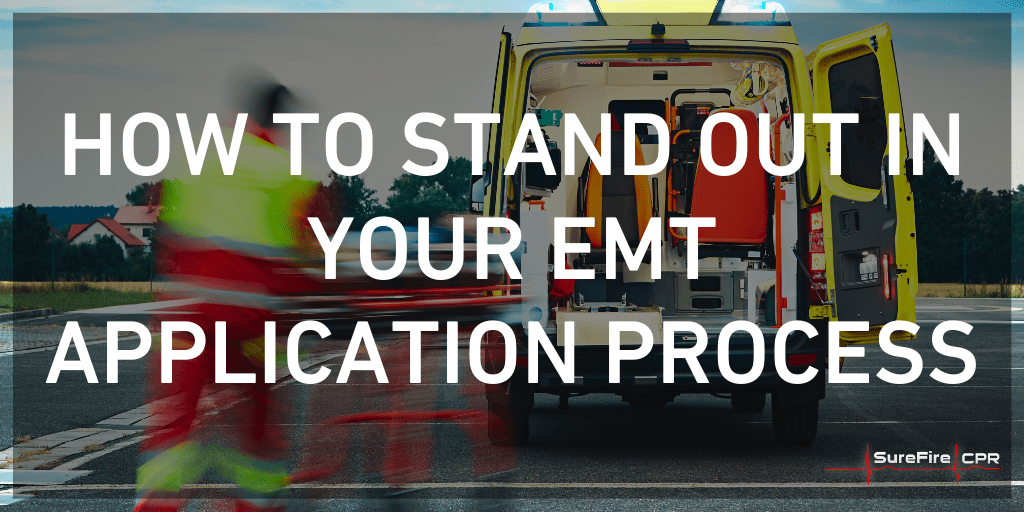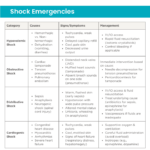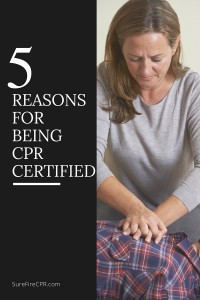The EMT job market is competitive. Many prospective EMTs are trying to enter the profession straight out of school, while others are switching into the profession from an adjacent or entirely different field. In both of these cases, the age-old career Catch-22 can sometimes surface. EMT jobs want candidates with work experience, but you can’t get experience without a job.
If this Catch-22 has you trapped, don’t despair. There are several steps you can take to stand out in the EMT application process, regardless of your prior job experience. In this comprehensive guide, our experts here at SureFire CPR cover each of them. Our team consists of a large number of EMTs and paramedics, many of whom are very familiar with the current EMT job market and the hiring requirements maintained by today’s fire departments, and private ambulance companies, and hospitals. We know what they’re looking for, and we’re here to pass that knowledge on to you. Read on to learn how to stand out in your EMT application process, and enroll in our award-winning Southern California certification courses today!
Get Your Required (and Non-Required!) Certifications
Every EMT should have certifications on his or her resume. Certifications are a great way to show your life-saving qualifications, and they’re usually pretty easy to obtain. You may not have gotten a job, but you can always get certified.
Start with BLS (Basic Life Support). A BLS certification is a baseline requirement for all EMTs. You won’t get far in the job application process without one. BLS is an intensive CPR class for healthcare providers that covers the following topics: CPR for individuals of all ages, conscious and unconscious choking aid, AED use, and more. Once you’ve obtained your BLS certification, move onto more advanced certifications that will separate you from other candidates. Start with ECG and Pharmacology, an advanced medical care course that will teach you the ins and outs of heart rhythms and medications used in emergency care. ECG and Pharmacology will also prepare for two additional courses: PALS (Pediatric Advanced Life Support) and ACLS (Advanced Cardiovascular Life Support).
ACLS covers advanced cardiovascular support techniques, airway management, and pharmacology for cardiovascular conditions. PALS covers specialized life support for pediatric patients. Having ECG and Pharmacology, ACLS, and PALS certifications on your resume will show that you are a highly-qualified candidate who is passionate about your profession. In almost every case, they will work in your favor. Consider them small but smart investments into your future.
To drive the point home even further: many of today’s EMS companies are starting to require their workers to obtain extra life-saving certifications before they step into an ambulance. Having American Heart Association certifications like PALS, ACLS, and PEARS beforehand will help you get a head start and will make you an attractive candidate from the get-go.
Find and Complete an EMT Program
If you want to be an EMT, you are going to have to complete a state-approved education program in emergency medical technology. Be wary of programs that don’t actually get you accredited in your own home state (the state you want to work in). They’re out there. Save yourself the headache by making sure you avoid these courses and only researching those that will get you accredited where you want to work. The Commission on Accreditation of Allied Health Education Programs has an online database of accredited EMT programs in each state. Check that database before you sign up for your EMT course.
Ace the Cognitive Exam
As you probably know, if you are hoping to be an EMT, you must first pass the National Registry Emergency Technician cognitive exam. This exam is a computerized test that runs between 60 and 110 questions. It must be taken at an authorized location with a proctor. Questions on the exam cover subjects such as respiration and ventilation, airways, cardiology and resuscitation, medical care, EMS operations, trauma, and obstetrics and gynecology. The National Registry of Emergency Medical Technicians states that a passing grade shows that a tester shows “a standard level of competency” in answering these basic questions. Competency is the benchmark, but it shouldn’t be the mark that you shoot for. To stand out on your application, you want the highest score possible. You want to exhibit a grade that shows a knowledge of the material far superior to others taking the test.
This is going to require you to really hit the books and study as much as possible. There are plenty of EMT Cognitive Exam prep books and practice tests available, some of which are completely free online, but many of which will require you to pay for. Buy some books. This is yet another investment in your future. A great grade on the cognitive exam may lead you to getting hired much faster than the rest of the applicants in the job pool.
Pass the Psychomotor Exam With Flying Colors
The other half of the EMT exam equation is the psychomotor test. Each state has a slightly different test that it administers at its emergency management services offices and/or local training institutes. To familiarize yourself with your state’s unique test, be sure to contact your state’s emergency management offices far in advance of your test date to know exactly what your test will cover. Once you have this information, it’s time to practice, practice, practice. Research industry-standard methods for each of the EMS psychomotor procedures so that you can come in doing the various tasks that you need to do, exactly how they are supposed to be done.
Examples of what you will see on the psychomotor test include providing mouth-to-mouth and other ventilating procedures, immobilizing spines, managing cardiac arrests, immobilizing dislocated joints, caring for bone fractures, conducting patient assessments, managing shock, and controlling bleeding. When you check with your state’s EMS office, be sure to ask the staff about how your state scores the exam. Ask them what score constitutes a passing grade, and more importantly, ask them what an exemplary score is. That’s the score that you want to shoot for while taking your psychomotor exam.
Get in Great Shape
As you practice your physical skills for the psychomotor exam, spend some extra time getting your entire body in shape. Working in emergency medical services is extremely physically taxing, so as you prepare for your interviews to come, you want to exhibit your athleticism and strength to interviewers. No, you’re not going to have to put your deadlift numbers on a resume, but your physical appearance does matter when interviewing for an EMS job. The healthier and more capable you look, the more likely you are to secure a position.
Put yourself in the shoes of an interviewer right now. You are deciding between two identical candidates on paper and you have now arrived at the in-person interview. Are you going to want to hire the gaunt and sickly-looking person who sits down in the chair opposite you, or are you going to want to hire the person who looks like a professional athlete? Industry expertise and common sense both say that the choice is easy. Working out for a few months may not turn you into a professional athlete, but it may just turn heads enough to land you your top EMT position.
Learn More and Earn Your Certifications With Our Experts Here at Surefire CPR
Want to learn more about how you can stand out from the competition in the EMT application process? Ready to get started by getting certified? Here at SureFire CPR, we have you covered. Based in Southern California, we proudly offer a wealth of certification classes, including BLS, ECG and Pharmacology, ACLS, PALS, , and many more. Our award-winning instructors have decades of combined experience in hospitals, ambulances, firehouse, and other professional EMS settings. With some of the best-priced and most frequently-offered classes in Los Angeles, Orange County, and the Inland Empire, we have certification courses to meet all schedules and budgets. Explore the links above to learn more and enroll with us today!
Sources
“Find a Program.” The Commission on Accreditation of Allied Health Education Programs.
“Emergency Medical Technicians (EMT) – The Cognitive Exam.” The National Registry of Emergency Medical Technicians.
“Emergency Medical Technicians (EMT) – The Psychomotor Exam.” The National Registry of Emergency Medical Technicians.










